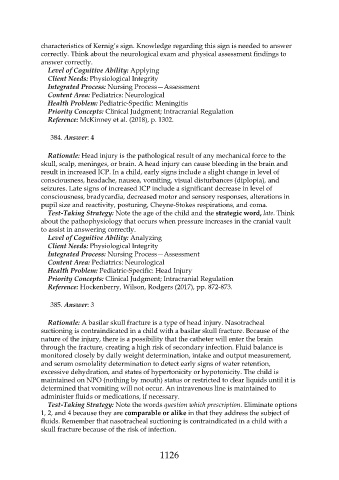Page 1126 - Saunders Comprehensive Review For NCLEX-RN
P. 1126
characteristics of Kernig’s sign. Knowledge regarding this sign is needed to answer
correctly. Think about the neurological exam and physical assessment findings to
answer correctly.
Level of Cognitive Ability: Applying
Client Needs: Physiological Integrity
Integrated Process: Nursing Process—Assessment
Content Area: Pediatrics: Neurological
Health Problem: Pediatric-Specific: Meningitis
Priority Concepts: Clinical Judgment; Intracranial Regulation
Reference: McKinney et al. (2018), p. 1302.
384. Answer: 4
Rationale: Head injury is the pathological result of any mechanical force to the
skull, scalp, meninges, or brain. A head injury can cause bleeding in the brain and
result in increased ICP. In a child, early signs include a slight change in level of
consciousness, headache, nausea, vomiting, visual disturbances (diplopia), and
seizures. Late signs of increased ICP include a significant decrease in level of
consciousness, bradycardia, decreased motor and sensory responses, alterations in
pupil size and reactivity, posturing, Cheyne-Stokes respirations, and coma.
Test-Taking Strategy: Note the age of the child and the strategic word, late. Think
about the pathophysiology that occurs when pressure increases in the cranial vault
to assist in answering correctly.
Level of Cognitive Ability: Analyzing
Client Needs: Physiological Integrity
Integrated Process: Nursing Process—Assessment
Content Area: Pediatrics: Neurological
Health Problem: Pediatric-Specific: Head Injury
Priority Concepts: Clinical Judgment; Intracranial Regulation
Reference: Hockenberry, Wilson, Rodgers (2017), pp. 872-873.
385. Answer: 3
Rationale: A basilar skull fracture is a type of head injury. Nasotracheal
suctioning is contraindicated in a child with a basilar skull fracture. Because of the
nature of the injury, there is a possibility that the catheter will enter the brain
through the fracture, creating a high risk of secondary infection. Fluid balance is
monitored closely by daily weight determination, intake and output measurement,
and serum osmolality determination to detect early signs of water retention,
excessive dehydration, and states of hypertonicity or hypotonicity. The child is
maintained on NPO (nothing by mouth) status or restricted to clear liquids until it is
determined that vomiting will not occur. An intravenous line is maintained to
administer fluids or medications, if necessary.
Test-Taking Strategy: Note the words question which prescription. Eliminate options
1, 2, and 4 because they are comparable or alike in that they address the subject of
fluids. Remember that nasotracheal suctioning is contraindicated in a child with a
skull fracture because of the risk of infection.
1126

